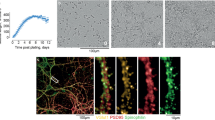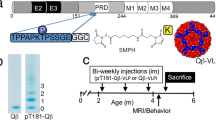Abstract
Only a few years ago, the idea that transmissible spongiform encephalopathies could be treated pharmacologically would have met with considerable scepticism. Even now, there is no way to cure a patient or animal suffering from a manifest prion disease. But recent, exciting developments seem to indicate that immunological and pharmacological interventions could have some potential for the pre-exposure and post-exposure prophylaxis of prion diseases. Although it is unlikely that we will be able to cure the clinically overt stages of prion diseases in the foreseeable future, palliative and even life-prolonging interventions might no longer be confined to the realm of science fiction.
This is a preview of subscription content, access via your institution
Access options
Subscribe to this journal
Receive 12 print issues and online access
$189.00 per year
only $15.75 per issue
Buy this article
- Purchase on Springer Link
- Instant access to full article PDF
Prices may be subject to local taxes which are calculated during checkout

Similar content being viewed by others
References
Aguzzi, A., Montrasio, F. & Kaeser, P. S. Prions: health scare and biological challenge. Nature Rev. Mol. Cell Biol. 2, 118–126 (2001).
Weissmann, C. & Aguzzi, A. Bovine spongiform encephalopathy and early onset variant Creutzfeldt–Jakob disease. Curr. Opin. Neurobiol. 7, 695–700 (1997).
Aguzzi, A. & Weissmann, C. Prion research: the next frontiers. Nature 389, 795–798 (1997).
Yamamoto, A., Lucas, J. J. & Hen, R. Reversal of neuropathology and motor dysfunction in a conditional model of Huntington's disease. Cell 101, 57–66 (2000).
Tremblay, P. et al. Doxycycline control of prion protein transgene expression modulates prion disease in mice. Proc. Natl Acad. Sci. USA 95, 12580–12585 (1998).
Bruce, M. E. et al. Transmissions to mice indicate that 'new variant' CJD is caused by the BSE agent. Nature 389, 498–501 (1997).
Hill, A. F. et al. The same prion strain causes vCJD and BSE. Nature 389, 448–450 (1997).
Aguzzi, A. Between cows and monkeys. Nature 381, 734 (1996).
Brandner, S. et al. Normal host prion protein necessary for scrapie-induced neurotoxicity. Nature 379, 339–343 (1996).
Korth, C., May, B. C., Cohen, F. E. & Prusiner, S. B. Acridine and phenothiazine derivatives as pharmacotherapeutics for prion disease. Proc. Natl Acad. Sci. USA 98, 9836–9841 (2001).
Roikhel, V. M., Fokina, G. I. & Pogodina, V. V. Influence of aminasine on experimental scrapie in mice. Acta Virol. 28, 321–324 (1984).
Doh-Ura, K., Iwaki, T. & Caughey, B. Lysosomotropic agents and cysteine protease inhibitors inhibit scrapie-associated prion protein accumulation. J. Virol. 74, 4894–4897 (2000).
Aguzzi, A. & Weissmann, C. Sleepless in Bologna: transmission of fatal familial insomnia. Trends Microbiol. 4, 129–131 (1996).
Caughey, B. & Race, R. E. Potent inhibition of scrapie-associated PrP accumulation by Congo red. J. Neurochem. 59, 768–771 (1992).
Pocchiari, M., Schmittinger, S. & Masullo, C. Amphotericin B delays the incubation period of scrapie in intracerebrally inoculated hamsters. J. Gen. Virol. 68, 219–223 (1987).
Tagliavini, F. et al. Effectiveness of anthracycline against experimental prion disease in Syrian hamsters. Science 276, 1119–1122 (1997).
Caughey, B. & Raymond, G. J. Sulfated polyanion inhibition of scrapie-associated PrP accumulation in cultured cells. J. Virol. 67, 643–650 (1993).
Farquhar, C., Dickinson, A. & Bruce, M. Prophylactic potential of pentosan polysulphate in transmissible spongiform encephalopathies. Lancet 353, 117 (1999).
Montrasio, F. et al. Impaired prion replication in spleens of mice lacking functional follicular dendritic cells. Science 288, 1257–1259 (2000).
Priola, S. A., Raines, A. & Caughey, W. S. Porphyrin and phthalocyanine antiscrapie compounds. Science 287, 1503–1506 (2000).
Supattapone, S. et al. Branched polyamines cure prion-infected neuroblastoma cells. J. Virol. 75, 3453–3461 (2001).
Soto, C. et al. Reversion of prion protein conformational changes by synthetic β-sheet breaker peptides. Lancet 355, 192–197 (2000).
Aguzzi, A. Neuro-immune connection in spread of prions in the body? Lancet 349, 742–743 (1997).
Nicotera, P. A route for prion neuroinvasion. Neuron 31, 345–348 (2001).
Heppner, F. L. et al. Transepithelial prion transport by M cells. Nature Med. 7, 976–977 (2001).
Mackay, F. & Browning, J. L. Turning off follicular dendritic cells. Nature 395, 26–27 (1998).
Mabbott, N. A., Mackay, F., Minns, F. & Bruce, M. E. Temporary inactivation of follicular dendritic cells delays neuroinvasion of scrapie. Nature Med. 6, 719–720 (2000).
Kitamura, D., Roes, J., Kuhn, R. & Rajewsky, K. A B cell-deficient mouse by targeted disruption of the membrane exon of the immunoglobulin mu chain gene. Nature 350, 423–426 (1991).
Klein, M. A. et al. A crucial role for B cells in neuroinvasive scrapie. Nature 390, 687–690 (1997).
Klein, M. A. et al. PrP expression in B lymphocytes is not required for prion neuroinvasion. Nature Med. 4, 1429–1433 (1998).
Shlomchik, M. J., Radebold, K., Duclos, N. & Manuelidis, L. Neuroinvasion by a Creutzfeldt–Jakob disease agent in the absence of B cells and follicular dendritic cells. Proc. Natl Acad. Sci. USA 98, 9289–9294 (2001).
Ware, C. F., VanArsdale, T. L., Crowe, P. D. & Browning, J. L. The ligands and receptors of the lymphotoxin system. Curr. Top. Microbiol. Immunol. 198, 175–218 (1995).
Futterer, A., Mink, K., Luz, A., Kosco-Vilbois, M. H. & Pfeffer, K. The lymphotoxin β receptor controls organogenesis and affinity maturation in peripheral lymphoid tissues. Immunity 9, 59–70 (1998).
Rennert, P. D., Browning, J. L., Mebius, R., Mackay, F. & Hochman, P. S. Surface lymphotoxin α/β complex is required for the development of peripheral lymphoid organs. J. Exp. Med. 184, 1999–2006 (1996).
Koni, P. A. et al. Distinct roles in lymphoid organogenesis for lymphotoxins α and β revealed in lymphotoxin β-deficient mice. Immunity 6, 491–500 (1997).
De Togni, P. et al. Abnormal development of peripheral lymphoid organs in mice deficient in lymphotoxin. Science 264, 703–707 (1994).
Korner, H. et al. Distinct roles for lymphotoxin-α and tumor necrosis factor in organogenesis and spatial organization of lymphoid tissue. Eur. J. Immunol. 27, 2600–2609 (1997).
Klein, M. A. et al. Complement facilitates early prion pathogenesis. Nature Med. 7, 488–492 (2001).
Mabbott, N. A., Bruce, M. E., Botto, M., Walport, M. J. & Pepys, M. B. Temporary depletion of complement component C3 or genetic deficiency of C1q significantly delays onset of scrapie. Nature Med. 7, 485–487 (2001).
Picklo, M. J. Methods of sympathetic degeneration and alteration. J. Auton. Nerv. Syst. 62, 111–125 (1997).
Glatzel, M., Heppner, F. L., Albers, K. M. & Aguzzi, A. Sympathetic innervation of lymphoreticular organs is rate limiting for prion neuroinvasion. Neuron 31, 25–34 (2001).
Carlson, S. L. et al. NGF modulates sympathetic innervation of lymphoid tissues. J. Neurosci. 15, 5892–5899 (1995).
Gabizon, R., McKinley, M. P., Groth, D. & Prusiner, S. B. Immunoaffinity purification and neutralization of scrapie prion infectivity. Proc. Natl Acad. Sci. USA 85, 6617–6621 (1988).
Horiuchi, M. & Caughey, B. Specific binding of normal prion protein to the scrapie form via a localized domain initiates its conversion to the protease-resistant state. EMBO J. 18, 3193–3203 (1999).
Enari, M., Flechsig, E. & Weissmann, C. Scrapie prion protein accumulation by scrapie-infected neuroblastoma cells abrogated by exposure to a prion protein antibody. Proc. Natl Acad. Sci. USA 98, 9295–9299 (2001).
Peretz, D. et al. Antibodies inhibit prion propagation and clear cell cultures of prion infectivity. Nature 412, 739–743 (2001).
Büeler, H. R. et al. Normal development and behaviour of mice lacking the neuronal cell-surface PrP protein. Nature 356, 577–582 (1992).
Brandner, S. et al. Normal host prion protein (PrPC) is required for scrapie spread within the central nervous system. Proc. Natl Acad. Sci. USA 93, 13148–13151 (1996).
Prusiner, S. B. et al. Ablation of the prion protein (PrP) gene in mice prevents scrapie and facilitates production of anti-PrP antibodies. Proc. Natl Acad. Sci. USA 90, 10608–10612 (1993).
Büeler, H. R. et al. Mice devoid of PrP are resistant to scrapie. Cell 73, 1339–1347 (1993).
Korth, C. et al. Prion (PrPSc)-specific epitope defined by a monoclonal antibody. Nature 390, 74–77 (1997).
Heppner, F. L. et al. Prevention of scrapie by transgenic anti-prion protein immunization. Science published online September 6 2001 (10.1126/science.1063093).
Acknowledgements
Supported by grants of the Bundesamt für Bildung und Wissenschaft, the National Centre of Competence in Research (NCCR-Neuro) and the Swiss National Foundation. We acknowledge technical help from P. Schwarz. F.L.H. is a Human Frontier Science Program and Stammbach Foundation fellow, and M.P. is a Deutsche Forschungsgemeinschaft fellow.
Author information
Authors and Affiliations
Corresponding author
Related links
Related links
DATABASE LINKS
Rights and permissions
About this article
Cite this article
Aguzzi, A., Glatzel, M., Montrasio, F. et al. Interventional strategies against prion diseases. Nat Rev Neurosci 2, 745–749 (2001). https://doi.org/10.1038/35094590
Issue Date:
DOI: https://doi.org/10.1038/35094590
This article is cited by
-
Rational targeting for prion therapeutics
Nature Reviews Neuroscience (2005)
-
Antiprion immunotherapy: to suppress or to stimulate?
Nature Reviews Immunology (2004)
-
Another piece of the prion puzzle
Nature Reviews Neuroscience (2004)
-
Diagnosing prion diseases: needs, challenges and hopes
Nature Reviews Microbiology (2004)
-
A camelid antibody fragment inhibits the formation of amyloid fibrils by human lysozyme
Nature (2003)



